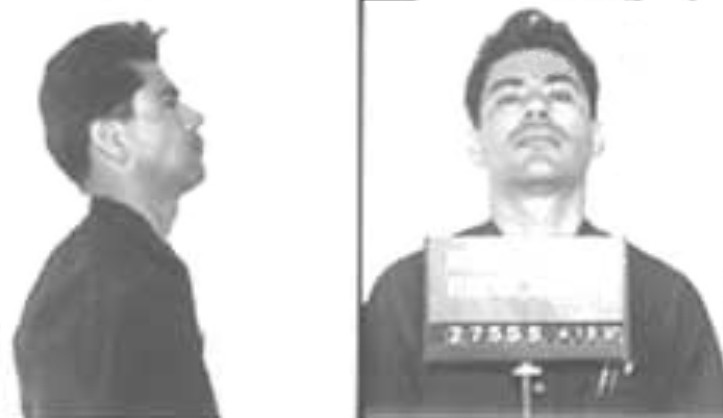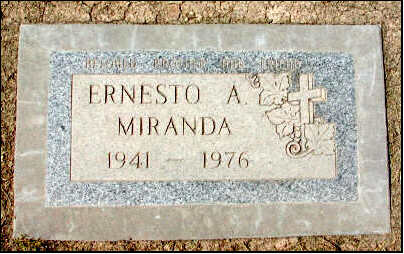 |
| The Phoenix Police Headquarters
at Washington and 7th Avenues. 8-01 |
For better than 40 years police have
been reading suspects their rights because of a landmark 1966 United
States Supreme Court case, Miranda v. ArizonaM1
That case had its origins in an interrogation room of the Phoenix
Police Department.
Ernesto Miranda was an eighth grade drop out with a criminal
record and pronounced sexual fantasies. On March 13, 1963,
Phoenix police went to his home and arrested him for the kidnap and
rape of a mildly retarded 18-year-old woman. He was taken to a
police station where a witness identified him. Two officers
questioned him in "Interrogation Room No. 2" of the
detective bureau. Two hours later, the officers emerged from the
interrogation room with a written confession signed by Miranda.
The confession had a paragraph typed at the top which stated the
confession was made "with full knowledge of my legal rights,
understanding any statement I make may be used against me."
 |
| Ernesto Miranda, 1963.
Public domain. |
At trial, no evidence was presented that Miranda had ever been
told that he did not have to talk to police or that he had the right
to a lawyer. The defense objected to letting the jury see the
confession, but the judge overruled the objection. He allowed
the jury to consider the written confession as well as officers
testimony about an oral confession made during the interrogation.
The jury found Miranda found guilty of kidnapping and rape.
He was sentenced to 20 to 30 years on each of the two counts, to be
served concurrently.
 |
| The "old" Maricopa
County Superior Court Building at Washington and Central
Avenues, erected in 1928. 8-01 |
The Supreme Court of the United States reviewed the case and
found that Miranda's Fifth AmendmentM2
right against self incrimination had been violated. Chief Justice
Earl Warren wrote the majority opinion of the Supreme Court which
stated that in order to combat the "inherently compelling
pressures which work to undermine the individual's will to
resist" during in-custody interrogation, "to permit a full
opportunity to exercise the privilege against self-incrimination,
the accused must be adequately and effectively apprised of his
rights and the exercise of those rights must be fully honored."
The court's opinion went on to state the now familiar statement
beginning with "You have the right to remain silent."
The result of the failure to give the Miranda warning does not
automatically result in the defendant going free. It only
means that the confession cannot be used against the defendant.
Ernesto Miranda was tried again without the confession. He was
convicted and served 11 years before he was paroled in 1972.
After several other returns to prison on other charges, he was
stabbed to death during an argument in a bar in 1976. He was
34. A suspect was arrested, but he chose to exercise his right
to remain silent after being read his Miranda rights. The
suspect was released, and no one was ever charged with the murder.
 |
| Grave of Ernesto Miranda at the
Mesa City Cemetery. The inscription in the blue border
at the top reads, "Beloved brother and friend."
3-02 |
The Miranda decision was seriously challenged when Congress
enacted 18 U. S. C. �3501. That statute allows a confession
to be admitted into evidence if it is found to be voluntary, even if
the defendant was not given the Miranda warning. The Supreme
Court reviewed this statute in Dickerson v. U.S., No. 99-5525 (June
26, 2000), and found that it was an invalid attempt to change the
result of the Miranda case. In a 7-2 vote, it held that the
Miranda warning requirement was based on the constitution, and that
Congress could not change it by legislation. As a result, the
requirement that the Miranda warnings be given in order for a
statement of the defendant to be admitted into evidence continues to
be the law, and has an ever greater majority on the Supreme Court
than the original holding. |
|
Footnotes and Sources for Mirandizing the Nation:
M1. Miranda
v. Arizona, 384 U.S. 436 (1966). The Miranda case from
which the rule takes its name was one of 4 cases combined for review
by the Supreme court where a confession taken without the defendant
being advised of his rights was admitted at trial. The other
cases were: Vignera v. New York [Michael Vignera was
convicted of the robbery of a Brooklyn dress shop. He was
subsequently adjudged a third-felony offender and sentenced to 30 to
60 years' imprisonment. Lower court conviction reversed.]; Westover
v. United States [Carl Calvin Westover was convicted of
robberies of a savings & loan and a bank in California. He
received two consecutive 15 year sentences. Lower courts conviction
reversed.]; California v. Stewart [Roy Allen Stewart
was convicted and sentenced to death for robbery and murder arising
out of a purse-snatch robbery in which the victim had died.
Appellate court's reversal affirmed.] John J. Flynn argued the
case for Miranda, and Gary K. Nelson, Assistant Attorney General of
Arizona argued the case for the State of Arizona. 
M2. "No person
shall be held to answer for a capital, or otherwise infamous crime,
unless on a presentment or indictment of a Grand Jury, except in
cases arising in the land or naval forces, or in the Militia, when
in actual service in time of War or public danger; nor shall any
person be subject for the same offense to be twice put in jeopardy
of life or limb; nor shall be compelled in any criminal case to
be a witness against himself, nor be deprived of life, liberty,
or property, without due process of law; nor shall private property
be taken for public use, without just compensation."
"Bill of Rights," Constitution of the United States,
Amendment V. [Emphasis added.] 
________, "Miranda
v. Arizona," britanica.com,
accessed 7-28-01.
________, Miranda v. Arizona, 384 U.S. 436 (1966).
Full text may be accessed at "MIRANDA
v. ARIZONA," Touro
College Law Center, accessed 7-28-01, and "MIRANDA
v. ARIZONA," FindLaw
for Legal Professionals, accessed 7-28-01.
________, "Supreme
Court reaffirms that police must read Miranda rights to criminal
suspects," CNN.com,
accessed 7-28-01.
________, "What
is the Miranda Warning?", CourtTV
Criminal Law, American Lawyer Media, L.P. and Little, Brown and
Company, Inc., accessed 7-28-01.
Gold, Susan Dudley, Miranda v. Arizona (1966),
Twenty-First Century Books, New York, 1995.
Riley, Gail Blasser, Miranda v. Arizona, Rights of
the Accused, Enslow Publishers, Hillside, New Jersey, 1994.
Warren, Earl, Warren's
handwritten notes concerning the Miranda decision, American
Treasures of the Library of Congress, The
Library of Congress, accessed 7-28-01.
Wice, Paul B., Miranda v. Arizona "You have
the right to remain silent...", Franklin Watts, Danbury,
Connecticut, 1996. |


